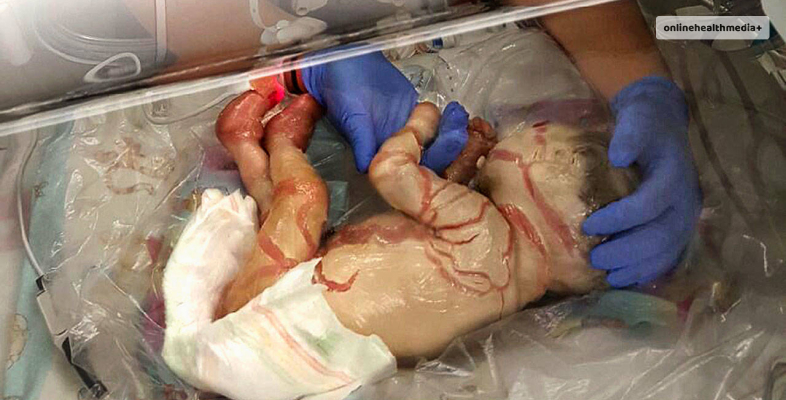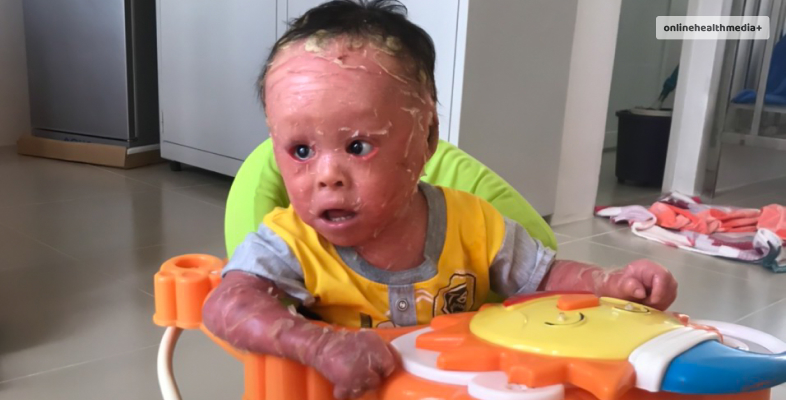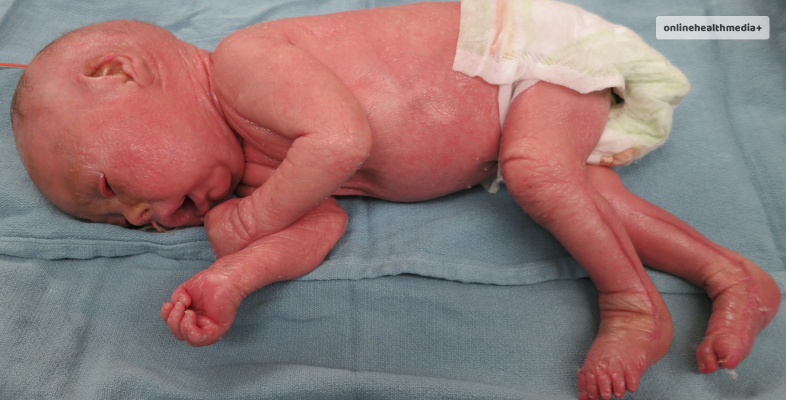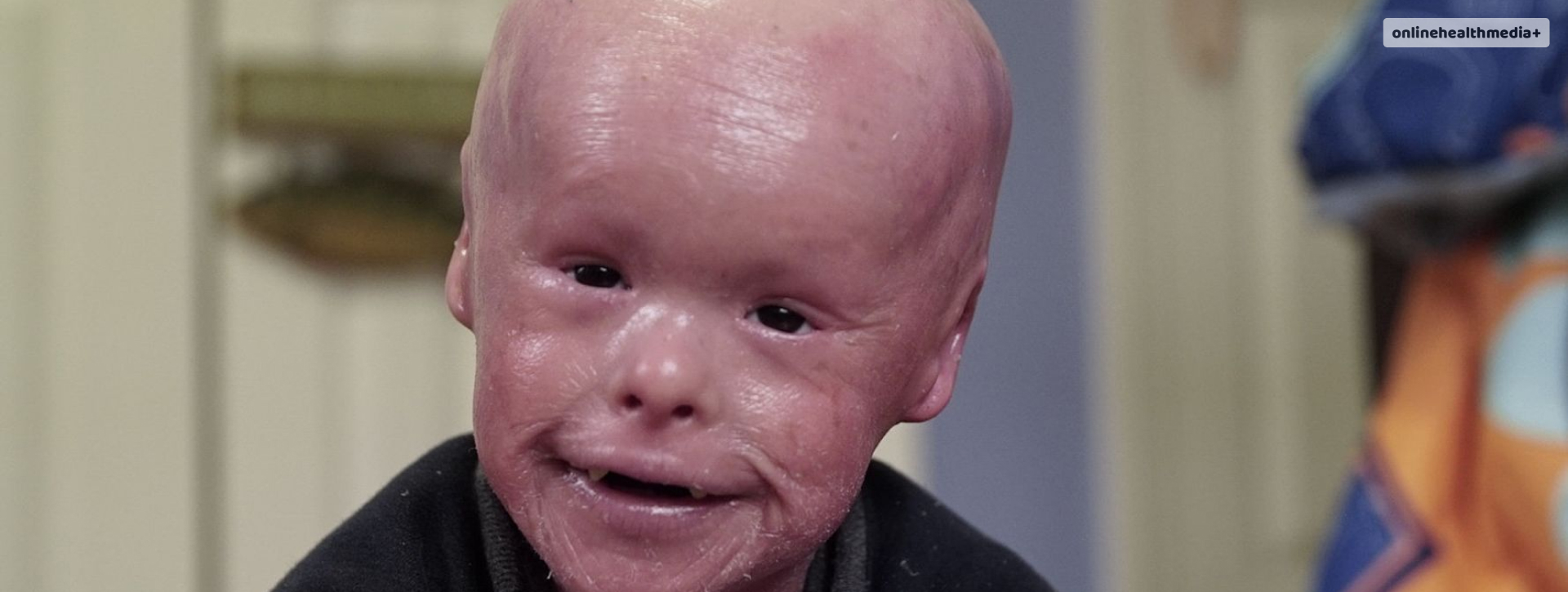Harlequin Ichthyosis: Everything You Need To Know About The Disorder.
Trigger warning: The following sections contain images and information that you may find disturbing.
It isn’t our beloved character from the DC universe- a person does not become a badass henchwoman for Joker. Harlequin ichthyosis is a rare genetic disorder that can result in thickening of the skin over a large area.
This skin thickening is over a large area and can lead to large rectangle- or diamond-shaped plates on the skin. These ‘plates’ are separated by deep cracks.
The condition can lead to complications such as restricted movement, breathing difficulties, premature birth, dehydration and infections.
If a child is diagnosed with the disorder, then they may experience premature birth and other complications such as dehydration, issues with body temperature,
The following sections will illustrate the different aspects of the disorder and provide an insight into the condition.
What Is Harlequin Ichthyosis?

Harlequin-type ichthyosis is a condition that results due to a mutation in the ABCA12 gene.
This gene codes for a protein that the body requires for transportation of lipids out of the cells. Hailed as the most severe type of ichthyosis, the condition is an autosomal recessive disorder.
This implies that it is inherited from parents who did not have the condition, but were “carriers” of the mutated gene.
Diagnosis
At least one in every 300,000 new babies had the diagnosis. Typically, it is discovered in its early stages during the standard checks performed at birth.
In addition to the child’s observation, the diagnosis includes genetic testing, which confirms the disease.
Imaging tests such as ultrasound and amniocentesis helps in further confirming the diagnosis. Usually, the children diagnosed with the condition do not live beyond the first week.
However, there have been cases where the survival rate varied from 10 months to 25 years.
Signs and Symptoms
Following are the signs and symptoms of the condition:
- The condition presents with thick ‘plates’ that are armor-like. This is known as hyperkeratosis. The condition is characterized by extreme hyperkeratosis that can be associated with the abnormal production of keratin in the cells.
- Severe facial and cranial deformities
- Poorly developed ears
- Everted eyelids, that can make them susceptible to infection.
- Lips may be pulled back due to dryness of the skin
- Joints may lack movement and may be below normal size
- Dehydration
- Sensitive to temperature changes
Hypoventilation and respiratory failure may occur as complications.
Treatment Of Harlequin Ichthyosis

Harlequin ichthyosis requires immediate medical attention at birth. Treatment primarily aims to manage symptoms and prevent complications. This includes:
1. Intensive skin care: The baby’s skin must be meticulously moisturized multiple times a day. Ointments, creams, and emollients are used to soften the skin.
2. Antibiotics: Because the skin’s barrier is compromised, bacterial infections are common. Therefore, antibiotic treatment is often necessary.
3. Artificial tears: To prevent eye damage due to ectropion, artificial tear drops may be administered.
4. Physical therapy: Gentle exercises to promote joint mobility and prevent contractures.
5. Nutritional support: Infants may require a feeding tube if they struggle to feed due to ectropion.
Psychosocial Impact

While Harlequin ichthyosis primarily affects the skin, it has profound psychosocial consequences for individuals and their families.
Coping with the condition can be emotionally challenging. Those living with Harlequin ichthyosis often face social stigma, isolation, and the need for continuous medical care.
In recent years, advocacy and support groups have emerged to connect affected individuals and their families, fostering a sense of community and providing resources for coping with the disorder’s unique challenges.
Living with Harlequin Ichthyosis not only involves physical challenges but also significant psychosocial aspects.
The condition’s highly visible and often severe skin manifestations can lead to emotional and psychological challenges for affected individuals.
Coping with the condition’s impact on self-esteem and mental health is an essential part of their journey.
- Emotional Impact: Harlequin Ichthyosis can be emotionally distressing for individuals, especially during childhood and adolescence when social interactions and peer relationships become crucial. The visible nature of the condition can lead to feelings of self-consciousness, anxiety, and depression.
- Support Networks: Emotional support from family, friends, and healthcare professionals is critical. Support groups and counseling can provide a safe space for individuals with Harlequin Ichthyosis to share their experiences, seek advice, and develop coping strategies.
- Coping Strategies: Over time, individuals with Harlequin Ichthyosis often develop resilience and effective coping strategies to manage the emotional challenges. These strategies can include building self-confidence, practicing self-acceptance, and focusing on personal strengths and achievements.
Research and Advances in Harlequin Ichthyosis

Ongoing research in the field of dermatology and genetics is shedding light on Harlequin Ichthyosis.
Despite its rarity, scientists and medical professionals are committed to improving the lives of those affected by the condition.
- Genetic Research: Advances in genetic research have led to a deeper understanding of the underlying mutations responsible for Harlequin Ichthyosis. This knowledge is crucial for the development of potential therapies in the future.
- Treatment Innovations: While there is currently no cure for Harlequin Ichthyosis, there have been innovations in treatment approaches. These include the use of specialized moisturizers and emollients to manage skin dryness, as well as antibiotics to prevent skin infections.
- Support Organizations: Research in the field often receives support from advocacy and research organizations. Collaborative efforts between medical professionals, researchers, and advocacy groups are driving progress in the understanding and treatment of Harlequin Ichthyosis.
Support Organizations for Harlequin Ichthyosis
Support organizations play a pivotal role in providing resources, information, and a sense of community for individuals and families dealing with Harlequin Ichthyosis.
- Foundation for Ichthyosis and Related Skin Types (FIRST): FIRST is a prominent organization that offers a wealth of resources, including educational materials, support networks, and information on the latest research and treatments. They host conferences and events to bring together affected individuals and their families.
- Online Support Groups: The internet has enabled the creation of online support groups and forums where individuals can connect, share their experiences, and seek advice. These virtual communities offer a sense of belonging and understanding.
- Advocacy and Awareness: Support organizations are often at the forefront of advocacy efforts to raise awareness about Harlequin Ichthyosis. They work to reduce stigma, promote research, and improve access to specialized care.
Preventive Measures and Genetic Counseling:
Given the genetic basis of Harlequin Ichthyosis, preventive measures are essential for individuals and families with a history of the condition.
- Genetic Counseling: Genetic counseling provides information and guidance to individuals or couples at risk of having a child with Harlequin Ichthyosis. It involves discussing inheritance patterns, risk assessment, and family planning options.
- Family Planning: Couples with a family history of Harlequin Ichthyosis may consider various family planning options, including pre-implantation genetic diagnosis (PGD) or adoption. Genetic counseling helps them make informed decisions.
- Health Professionals and Specialists: Individuals with Harlequin Ichthyosis benefit from the expertise of medical professionals who understand the condition and its management.
- Dermatologists: Dermatologists specializing in rare skin disorders are best equipped to diagnose and manage Harlequin Ichthyosis. They can provide personalized treatment plans and guidance.
- Geneticists: Geneticists play a crucial role in genetic counseling and testing for individuals and families with a history of Harlequin Ichthyosis. They can provide valuable insights into inheritance patterns and risks.
- Pediatricians: In the case of children with Harlequin Ichthyosis, pediatricians work in collaboration with dermatologists to ensure comprehensive care.
Global Incidence and Demographics:
Understanding the global incidence and demographics of Harlequin Ichthyosis helps shed light on its prevalence and impact.
- Global Prevalence: Harlequin Ichthyosis is an extremely rare condition, with an estimated incidence of 1 in 500,000 to 1 in 1,000,000 live births.
- Demographics: The condition affects individuals of various ethnicities and geographical locations, indicating that it is not confined to specific populations.
Wrapping It Up!
In conclusion, Harlequin ichthyosis is a rare, severe genetic skin disorder that demands a multidisciplinary approach for medical management and psychosocial support.
While living with this condition poses significant challenges, understanding and empathy from the community can significantly improve the quality of life for those affected.
It’s essential to emphasize the resilience and hope that individuals and families affected by the condition demonstrate.
Despite the significant challenges posed by Harlequin Ichthyosis, affected individuals often display remarkable resilience in facing daily obstacles and embracing life with determination.
Advances in research and medical care continue to progress, offering the potential for improved treatments and a better quality of life for those living with the condition.
Also Read



